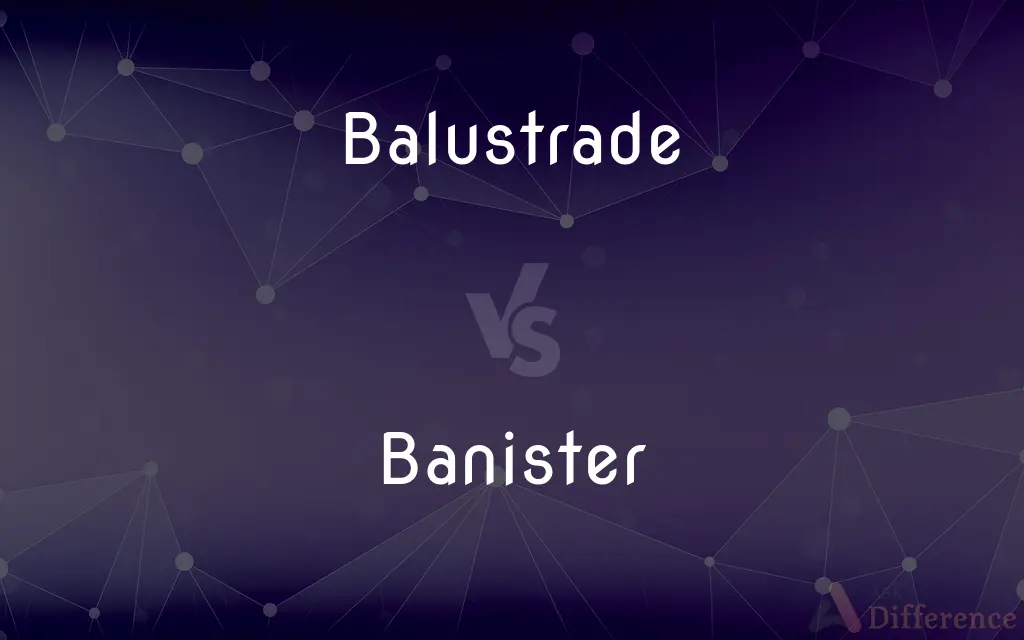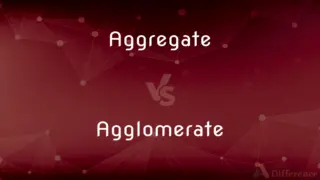Balustrade vs. Banister — What's the Difference?
Edited by Tayyaba Rehman — By Maham Liaqat — Updated on April 26, 2024
Balustrades are structural barriers often made of multiple posts called balusters, supporting railings along staircases and balconies, while a banister specifically refers to the handrail on a staircase.

Difference Between Balustrade and Banister
Table of Contents
ADVERTISEMENT
Key Differences
A balustrade is a series of balusters that support a railing, typically found on balconies, staircases, or around terraces, providing both safety and aesthetic appeal. On the other hand, a banister refers specifically to the handrail of a staircase, which is often supported by balusters but is primarily designed for hand support and safety during stair ascent or descent.
Balustrades can be made from various materials, including wood, stone, metal, or glass, and are crucial for structural integrity and architectural design in buildings. Whereas a banister, while it can also be made from similar materials, primarily focuses on ergonomics and usability, ensuring a comfortable and secure grip.
The design of balustrades is often intricate, involving patterns or designs that contribute to the overall aesthetic of a space. In contrast, banisters may feature a simpler design, emphasizing functionality and safety over elaborate decorative details.
In historical and architectural contexts, balustrades serve as a key element in defining the style and era of a building, reflecting classical, modern, or contemporary influences. On the other hand, banisters, though they can also be stylistically significant, are more focused on complying with safety regulations and ergonomic standards.
Installation of a balustrade requires consideration of both aesthetic alignment and structural support across a longer span, such as around a balcony or along a flight of stairs. Conversely, installing a banister is typically more straightforward, focusing on the strength and stability of the handrail along the staircase.
ADVERTISEMENT
Comparison Chart
Definition
A series of balusters supporting a rail
A handrail on a staircase
Primary Function
Safety and aesthetics
Safety and hand support
Location
Staircases, balconies, terraces
Staircases
Materials
Wood, stone, metal, glass
Wood, stone, metal, glass
Design Importance
High, often decorative
Lower, focused on function
Compare with Definitions
Balustrade
A protective barrier that also serves decorative purposes.
The glass balustrade provided an unobstructed view of the garden.
Banister
Focuses on safety and ergonomic design.
The newly installed banister made the staircase much safer for the elderly residents.
Balustrade
A structure consisting of a row of balusters topped by a rail.
The stone balustrade around the terrace added a classical touch to the building’s exterior.
Banister
Can be a standalone handrail or part of a larger staircase framework.
The banister ran along the entire length of the winding staircase.
Balustrade
Commonly used in stairways, balconies, and around open terraces.
The wooden balustrade along the staircase complemented the rustic interior design.
Banister
The handrail of a staircase.
She held onto the banister as she ascended the steep stairs.
Balustrade
Can be made from various materials to match architectural styles.
The modern home featured a sleek metal balustrade that matched its minimalist aesthetic.
Banister
Typically less decorative than balustrades.
The simple wooden banister was designed for functionality over aesthetics.
Balustrade
Often involves intricate design elements.
The marble balustrade featured intricate carvings that captured the late Renaissance style.
Banister
Often supported by balusters but functions primarily as a hand support.
The oak banister was polished to a high shine, providing both beauty and grip.
Balustrade
A railing supported by balusters, especially one forming an ornamental parapet to a balcony, bridge, or terrace.
Banister
The structure formed by the uprights and handrail at the side of a staircase
He vaulted the banister
She peered over the banisters
Balustrade
A rail and the row of balusters or posts that support it, as along the front of a gallery.
Banister
A handrail, especially on a staircase.
Balustrade
A row of balusters topped by a rail, serving as an open parapet, as along the edge of a balcony, terrace, bridge, staircase, or the eaves of a building.
Banister
Such a handrail together with its supporting structures.
Balustrade
A row of balusters topped by a rail, serving as an open parapet, as along the edge of a balcony, terrace, bridge, or the eaves of a building, or as a guard railing on a staircase; - it serves as a guard to prevent people from falling.
Banister
One of the vertical supports of a handrail; a baluster.
Balustrade
A railing at the side of a staircase or balcony to prevent people from falling
Banister
The handrail on the side of a staircase.
Banister
One of the vertical supports of a handrail; a baluster.
Banister
To construct a banister
Banister
To act as a banister
Banister
A baluster.
Banister
The balustrade of a staircase. Formerly used in this sense mostly in the plural, now mostly in the singular.
He struggled to ascend the pulpit stairs, holding hard on the banisters. Sir W. Scott.
Banister
A railing at the side of a staircase or balcony to prevent people from falling
Common Curiosities
What is a balustrade?
A balustrade is a row of balusters topped by a rail, serving as a safety barrier and decorative architectural element.
How do the materials differ between balustrades and banisters?
The materials can be the same, including wood, metal, or glass, but the design and finish may differ, focusing on aesthetics for balustrades and functionality for banisters.
Can balustrades be customized?
Yes, balustrades can be highly customized in terms of materials, design, and colors to fit specific architectural styles and personal tastes.
Are balustrades only used outdoors?
No, balustrades can be used both indoors and outdoors, such as around indoor staircases, balconies, and outdoor terraces.
What maintenance is required for balustrades compared to banisters?
Maintenance varies by material but generally includes regular cleaning, inspection for damage, and occasional refinishing or repainting to maintain appearance and integrity.
What is a banister?
A banister is the handrail of a staircase, primarily designed for hand support and safety.
Where are balustrades most commonly used?
Balustrades are commonly used in stairways, balconies, and around terraces.
How do I choose the right design for a balustrade or banister?
Choosing the right design depends on the architectural style of the building, the intended use, safety requirements, and personal aesthetic preferences.
Can a banister be part of a balustrade?
Yes, a banister can be part of a balustrade when it serves as the handrail supported by balusters.
Can the term 'banister' be used interchangeably with 'handrail'?
While often used interchangeably in casual conversation, technically, a banister includes both the handrail and its supporting balusters, whereas a handrail might stand alone or be part of a different structure.
What safety standards apply to balustrades and banisters?
Both balustrades and banisters must adhere to specific building codes that ensure they are strong enough to support weight and prevent falls, with regulations varying by region.
Is there a difference in the cost of installing a balustrade versus a banister?
Typically, a balustrade might cost more to install due to its larger size and often more intricate designs compared to a simpler banister installation.
How do balustrades impact the architectural aesthetics of a building?
Balustrades can significantly enhance a building's aesthetic by adding ornamental elements that reflect historical periods or modern designs.
Share Your Discovery

Previous Comparison
Sure vs. Certain
Next Comparison
Aggregate vs. AgglomerateAuthor Spotlight
Written by
Maham LiaqatEdited by
Tayyaba RehmanTayyaba Rehman is a distinguished writer, currently serving as a primary contributor to askdifference.com. As a researcher in semantics and etymology, Tayyaba's passion for the complexity of languages and their distinctions has found a perfect home on the platform. Tayyaba delves into the intricacies of language, distinguishing between commonly confused words and phrases, thereby providing clarity for readers worldwide.













































